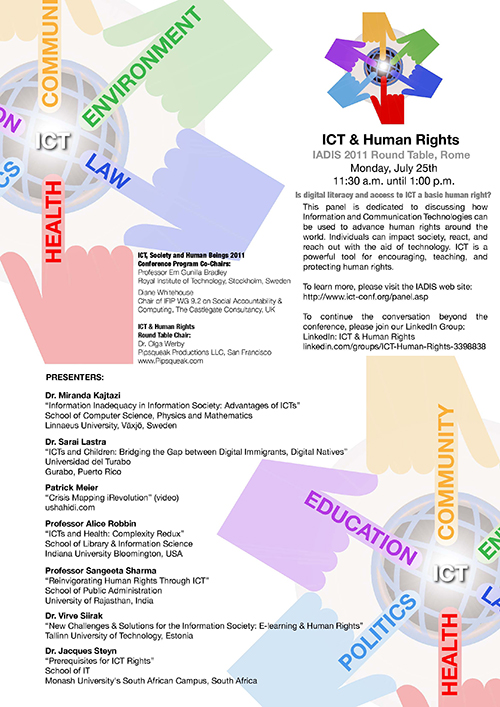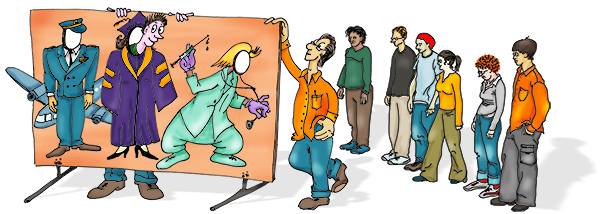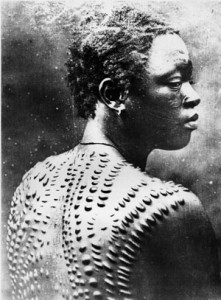
Here’s a nice collection of bus ads. The design of the ads was carefully targeted to the delivery vehicle (pun intended). Enjoy!

ICT & Human Rights Panel at IADIS The presenters in attendance, in order of presentation: Professor Sangeeta Sharma Title of presentation: Reinvigorating Human Rights Through ICT School of Public Administration University of Rajasthan, India Professor Alice Robbin Title of presentation: ICTs and Health: Complexity Redux Indiana University Bloomington Dr. Sarai Lastra Title of presentation: ICTs and Children: Bridging the Gap between Digital Immigrants, Digital Natives Universidad del Turabo Gurabo, Puerto Rico Dr. Miranda Kajtazi Title of presentation: Information Inadequacy in Information Society: advantages of ICTs School of Computer Science, Physics and Mathematics Linnaeus University, Växjö, Sweden Dr. Jacques Steyn Title of presentation: Prerequisites for ICT Rights School of IT Monash South Africa Patrick Meier and Dr. Virve Siirak were unable to attend in person. I summarized Patrick’s work in my opening statement and I hope Dr. Siirak would comment on his work below or on our LinkedIn community (ICT & Human Rights—all are welcome to join our open group). Opening Statement I chose to introduce each subtopic of the panel as part of my opening statement and to give it a slightly unusual take for each topic. Below are my notes and I’ve posted the PDF of my KeyNote on…
“Lost in Translation” was a wonderful movie by Sofia Coppola, starring Bill Murray and Scarlett Johansson. It depicted the delicious confusion of Western tourists in total Japanese cultural emersion. In particular, the scenes where Bill Murray shoots a liquor commercial for the Japanese market are simply priceless. In retrospect, I see where Ms. Coppola got her ideas. Her cousin, Nicholas Cage, have been making wonderfully odd (to our sensibilities) commercials for years. He clearly had stories to share. Here are a few of his gems, courtesy the World Wide Web: and But it’s not only Japan that surprises our/my cultural biases. This morning, my husband and I went to a local grocery store in Rome, Italy. In the cheese section, there was a little paper bottle of parmesan cheese with a mouse of the package. The mouse didn’t work for me at all! So much for cultural differences. Here’s a small collection of ads for McDonalds from all over the world. Please compare it to the packaging and menus for this restaurant chain that I’ve posted here in the past: “Cultural World Domination”. Notice all of the anchoring errors, metaphor mistakes, cultural biases, mirroring errors, and general cognitive and cultural…
Making Money on a Bet Yesterday, I came across a little post on LinkedIn: L.G. update: “I have a bet with one of my colleagues today. He thinks that using LinkedIn is a waste of time and does not see the benefit. So he has agreed to give me £1 for every like/comment I get. Considering I have over 2000 connections I reckon I will get £300 easy out of this. Start liking this update people!” It wasn’t from anyone I knew. But a LOT of people I did know (and are linked to) commented and liked this update. I added my like as well. To date (the original comment was made 2 days ago), there are 6,298 likes and 1,286 comments! Mr. L.G. stands to make some money here. With Google+, Facebook, Twitter, and the like, all pushing the value of social networking, it was interesting to see this little experiment making a direct conversion from social networking to money. And it’s not over—the post sparked an emotional response among the members of LinkedIn. The emotional trigger is still there. With each new like and comment, the temptation to add another like on the pile grows. It’s contagious!

Empathy is a necessary component of product design. To design and make something that is comfortable to use for someone else, requires the maker of the product to imagine how another human being would feel while using it. This is a hard thing to do. Medical students have to take “bed side manners” classes that explicitly teach empathy for the patient. Some design schools do the same (check out this video in Product Design Resources). Fortunately, humans come equipped with a special region in the brain whose job it is to help us see the world from another’s point of view. Here’s a short introduction by Rebecca Saxe, “How we read each other’s minds.” So when we go to the movies, we relate to the characters and feel what they feel, and cry when they are sad, and laugh when they are happy, and cringe when things get awkward, because we have the Right TPJ (or RTPJ) region in our brain just behind and above our right ear. We aren’t born ready to use this part of our brain, as the experiments described by Dr. Saxe in the video show. It takes a long time for this social problem solving…

When we first arrived in New York as Russian refugees many, many years ago, everything was so confusing. I remember lying on the bed in a hotel room somewhere in Brighton Beach, Brooklyn, with my whole family (mother, father, sister, and me) and watching commercials on TV. There was a stick figure running around the screen screaming “Cherio-o-o-o-o-o-o-o-s.” We debated for hours trying figure out what it was about. And then there was a time when my parents let me buy a bag of Cheetos. I almost vomited when I tried one—in Russia, things that looked like that were sweet. The complete mismatch between my expectations and the actual taste made me gag. To this day, I hate the stuff! So when companies are on the path of world domination with their products, understanding cultural differences in background knowledge, perceptual expectations, preferred ways of doing things is a must. To see how some giants customize their products to make them more culturally sensitive, I took a look at McDonalds‘ menus from around the world. Check it out: Note: I went looking for the old Cheerios commercial, but could only find this one—it’s close, but the one we saw didn’t have…

People have been flashing “bling” around since the cave days. But what we perceive as “bling” has changed dramatically over the years and over cultures. We are social animals, we put a lot of value in our place in the social hierarchy of the group. By demonstrating wealth, we are advertising our social status in the community. Body Image How can you tell how much influence a cave man had in his group? Well, one was probably the way he looked: body paint, tattoos, scarification, body modification, hairdos, teeth filings, nail beautification, and accessories. And while somethings were transitory—beads are easily lost in battle, nails broken during a hunt—some are permanent status symbols. When all you owe is carried on you, then permanent modifications is a good solution to broadcasting your importance and achievements to the group. Each scar carries meaning and is much easier to show off than notches on the bed post. But body modifications is a very painful bling. Products Once the society is a bit more stable, stuff becames a preferred way of social display. Jewelry can be worn, homes can be owned, cars can be seen—there are many ways to show off wealth in the…